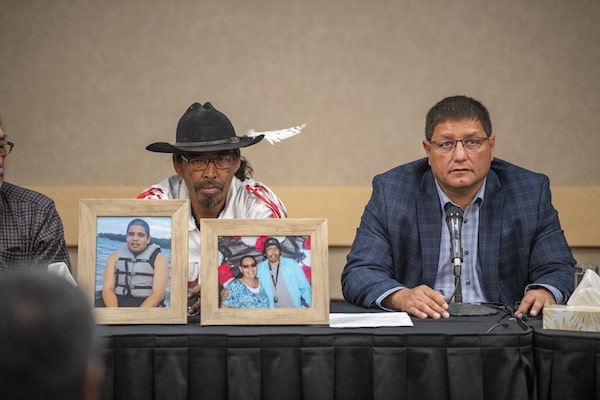
Mark Arcand, right, whose sister Bonnie Burns and nephew Gregory (Jonesy) Burns were killed during a series of violent attacks at James Smith Cree Nation and Brian (Buggy) Burns, left, Bonnie Burns's husband, speak to media at a press conference in Saskatoon on Sept. 7, 2022.Liam Richards/The Canadian Press
Brian (Buggy) Burns says it’s the small things he misses the most, like sitting down and having coffee with his wife nearly every morning for more than three decades.
Since his wife, Bonnie, and son Gregory were killed in a mass stabbing, coffee just hasn’t tasted the same. Jokes haven’t been as funny.
And, Burns says, there is no place to call home.
“I miss talking to her and joking around,” Burns says while holding back tears. “I’d make sure I had her coffee for her before she went to work.”
The Sept. 4 stabbing rampage left 11 people dead and 18 injured on the James Smith Cree Nation and in the nearby village of Weldon, Sask., northeast of Saskatoon.
How four days of horror unfolded on James Smith Cree Nation, where everyone lost someone
Myles Sanderson, 32, the suspect in the attacks, later died in police custody.
Houses became crime scenes on the First Nation of about 1,900 people 170 kilometres northeast of Saskatoon. Even after police left, some families devastated by the massacre can’t fathom returning to those homes.
“It still hurts,” says James Smith Cree Nation Chief Wally Burns.
He expects there are four families, including that of Brian Burns, who are struggling to decide whether to go back to their houses. The First Nation is trying to find solutions, he says, including providing ready-to-move homes that can be placed at a site but don’t have a basement.
But the chief says it relies on funding from Ottawa.
“It’s a slow process with government.”
Indigenous Services Canada will provide funding for four homes, said Matthew Gutsch, a spokesperson for the department. However, due to winter conditions they may not be ready for use until next spring, Gutsch added in an email.
In the meantime, he said the department will provide funding for families who cannot return to the community.
Indigenous Services Canada said a total of 17 homes were damaged during the rampage. Funding is also being provided to clean, restore and repair those that will not be replaced, Gutsch said.
The devastating memories of the deaths of Brian Burns’ wife and son are held in the walls of their house.
Bonnie, 48, and Gregory, 28, who was called “Jonesy” by family, were both killed during the attack at the family home. Gloria Lydia Burns, a 61-year-old community member, also died trying to assist Bonnie, who called for help from her home.
There were three other children and two grandchildren in there at the time. Another 14-year-old son was stabbed but survived.
Brian Burns says that son shakes when he thinks about returning.
Brian Burns built the home seven years ago. After the massacre, he says there was blood everywhere.
Now he wants to see it burned down and a monument and three crosses put in its place.
“When you have a murder in your house, you are supposed to burn your place down and start over,” he says. “So, I am just following customs and protocol from what my traditional ways are.”
Since the stabbings, Brian Burns has been sharing a hotel room in Melfort, Sask., 40 kilometres south of the First Nation, with his three surviving sons, granddaughter and grandson.
“We are tired of hotel life. We are tired of takeout meals,” he says. “We just want some home-cooked meals and a home.”
He says they have already received so much support and it means a lot to his family. He has been told they will get a ready-to-move home but doesn’t know when.
Until then, he hopes to find a place to rent in Melfort so his children can at least experience Christmas at a home.
For his wife, it was an important holiday when everyone would come together to share food and love, Brian Burns says. There will be empty seats this year, but he says he’s doing his best.
“Me and Bonnie, we’d cook a big meal,” he says through sobs. “I’ll make sure those boys have a gift. I’ll make sure they have a turkey meal. It might be in a hotel room, but I hope not.”